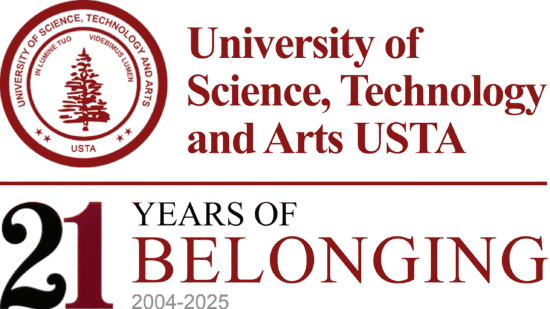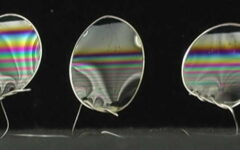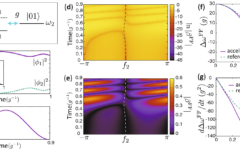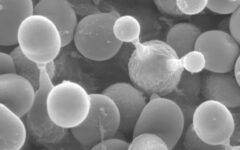Physics: Toward a practical nuclear pendulum
16 August 2023 2023-08-16 13:21Physics: Toward a practical nuclear pendulum
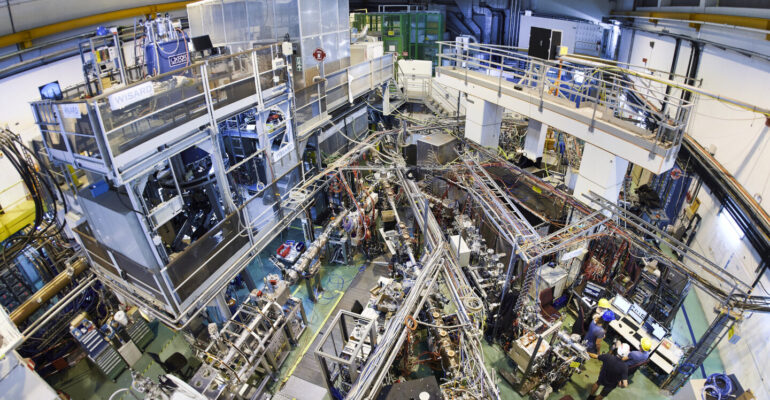
Physics: Toward a practical nuclear pendulum
Source: Ludwig-Maximilians-Universitaet Muenchen (LMU)
Summary: For the first time, researchers have measured the lifetime of an excited state in the nucleus of an unstable element. This is a major step toward a nuclear clock that could keep even better time than today’s best atomic timekeepers.
Researchers from Ludwig-Maximilians-Universitaet (LMU) Munich have, for the first time, measured the lifetime of an excited state in the nucleus of an unstable element. This is a major step toward a nuclear clock that could keep even better time than today’s best atomic timekeepers.
Atomic clocks are the most precise chronometers we now have. These timekeepers are based on precise knowledge of the frequency of specific transitions between defined energy levels in the electron shells of certain atoms. Theoretical studies suggest that nuclear clocks that make use of analogous changes in the energy states of atomic nuclei could provide even more accurate frequency standards for timekeeping purposes. Research teams around the world are now exploring ways of turning this theoretical possibility into a practical reality.
Early last summer, physicists Dr. Peter Thirolf, Lars von der Wense and Benedict Seiferle at LMU’s Chair of Medical Physics, in collaboration with colleagues in Mainz and Darmstadt, achieved a notable breakthrough in the quest to develop a functioning nuclear clock. In a paper published in the journal Nature, they reported the first experimental detection of a specific energy transition in the nucleus of a particular isotope of the element thorium (Th) that had been predicted decades ago. The nucleus of this unstable isotope, which has an atomic weight of 229, is the only nucleus known to have the properties required for the development of a practical nuclear clock.
With financial support from the EU-funded project nuClock, Thirolf, von der Wense and Seiferle have continued to characterize the energy transition in the 229Th nucleus, and have now succeeded in measuring the lifetime of the excited nuclear state. Their findings appear in the journal Physical Review Letters.
“This represents the direct experimentally determined value for the half-life of the excited state of the isotope 229Th,” says Benedict Seiferle. The LMU team now plans to measure the energy of the transition itself. With these data in hand, it should be possible in the future to optically induce the transition in a controlled fashion with the help of an appropriately designed laser.
Related Posts
Synchrotron sheds (X-ray) light on carbon chemistry at ocean surfaces
Physics of bubbles could explain language patterns
Frequency modulation accelerates the research of quantum technologies
Fungal spores harness physics to launch themselves
Physics explains protein unpredictability
Search
Categories
- Acoustics (1)
- Admission (14)
- Alumni (19)
- Bacteria (1)
- Behavioral Science (1)
- Biochemistry (1)
- Biochemistry Research (1)
- Biology (1)
- Biotechnology (1)
- Blog (10)
- Botany (1)
- Career (14)
- Cell Biology (1)
- Chemistry (1)
- Chemistry (1)
- Developmental Biology (1)
- Epigenetics Research (1)
- Evolutionary Biology (1)
- Fungus (1)
- Fungus (1)
- Genetics (1)
- Health (1)
- Inorganic Chemistry (1)
- Life Sciences (1)
- Marine Biology (1)
- Mating and Breeding (1)
- Microbes and More (1)
- Microbiology (1)
- Molecular Biology (1)
- Nature of Water (1)
- News (39)
- Optics (1)
- Organic Chemistry (1)
- Physics (1)
- Prions (1)
- Prions (1)
- Quantum Computing (1)
- Quantum Physics (1)
- Research (38)
- Spotlight (15)
- Student life (15)
- Student story (13)
- Technology (1)
- Thermodynamics (1)
- Ultrasound (1)
- Uncategorized (10)
- Virology (1)
- Zika Virus Research (1)
- Zoology (1)
Get the latest University of Science, Technology and Arts news
Carborane-Cluster-Wrapped Copper Cluster with Cyclodextrin-like Cavities for Chiral Recognition | Journal of the American Chemical Society #Carborane #Cluster #Cu #Cyclodextrin #Chiral #Recognition
This week in #LCSOSynthesisProblem @DuncanBrownsey challenged us with the total synthesis of Wickerol A and B by Gui and coworkers @Jinghan_Gui in @J_A_C_S. #TotalSynthesis #Chemistry
Take a look: https://www.epfl.ch/labs/lcso/wp-content/uploads/2024/06/Wickerol-A-Gui-2020.pdf
Original paper: https://pubs.acs.org/doi/10.1021/jacs.9b11838
Modified Halloysite as Catalyst for the Conversion of Hydroxymethylfurfural to Furandicarboxylic Acid: A DFT Investigation (Dario Duca and co-workers)
Topological electride of 𝑡-YCl, Yiwei Liang, Xinyan Lin, Biao Wan, Zhaopeng Guo, Xuyan Cao, Dexi Shao, Jian Sun, and Huiyang Gou #CondensedMatter #ChemicalPhysics https://go.aps.org/3VwcMZ5
G-Quadruplex mRNAs Silencing with Inducible Ribonuclease Targeting Chimera for Precision Tumor Therapy | Journal of the American Chemical Society #Quadruplex #mRNA #Silencing #Ribonuclease #Chimera #Tumor #Therapy
Polycationic Open‐Shell Cyclophanes: Synthesis of Electron‐Rich Chiral Macrocycles, and Redox‐Dependent Electronic States – Shi – Angewandte Chemie International Edition – Wiley Online Library
Perspective on the Development of Monomer Recovery Technologies from Plastics Designed to Last
A Perspective by Steffan K. Kristensen, Troels Skrydstrup et al. @AarhusUni_int
🔓 Open access in ACS Organic & Inorganic Au 👉 https://go.acs.org/9Gv
A fantastic collection of activities to provoke and deepen mathematical thinking. ‘Thinkers’ will enhance the teaching and learning of mathematics for new and experienced teachers, and for learners from 8 to 18 (and beyond). http://bit.ly/ATMthinkers.
ICYMI, from our Emerging Investigators collection 🎉
‘Gold-catalyzed benzannulations of 2-alkenylindoles with alkynes: a protecting-group-free regioselective approach to carbazoles’ by Youliang Wang at Xi’an Jiaotong University.
Catalyst-Free α-trans-Selective Hydroboration and (E)-Selective Deuterated Semihydrogenation of Alkynyl Sulfones (@JOC_OL): https://pubs.acs.org/doi/10.1021/acs.joc.3c02833.
https://www.organic-chemistry.org/abstracts/lit3/936.shtm
A simple continuous hydrogenation of alkenes and alkynes with in situ generated diimide
Molecular Triplet Generation Enabled by Adjacent Metal Nanoparticles | Journal of the American Chemical Society #Triplet #Generation #Metal #Nanoparticles
Photonic implementation of the quantum Morra game, Andrés Ulibarrena, Alejandro Sopena, Russell Brooks, Daniel Centeno, Joseph Ho, Germán Sierra, and Alessandro Fedrizzi #Quantum #QuantumInformation https://go.aps.org/45eWCru
We’re excited to share our latest preprint on @ChemRxiv! The talented @Zhipengluu developed a new photo-active hypervalent iodine reagent for the diversification of aliphatic C–H bonds. Check it out: https://chemrxiv.org/engage/chemrxiv/article-details/665755b321291e5d1d8dfdbf
Now in @InorgChem! Read the article featuring pyrazine (pz)-bridged dinuclear Ru2(II,II) and Ru2(III,III) complexes and pz-containing mononuclear Ru(II) and Ru(III) complexes, which were afforded through the reactions of the (μ-Cl)3 Ru(II,II) complex: https://go.acs.org/9Gq
Long-Range Gating in Single-Molecule One-Dimensional Topological Insulators | Journal of the American Chemical Society @ColumbiaScience @Columbia @ChemColumbia @APAMMSECU #Gating #Topological #Insulators
Diastereo- and Enantioselective Construction of Stereochemical Arrays Exploiting Non-Classical Hydrogen Bonding in Enolborates (@ChemEurJ): https://chemistry-europe.onlinelibrary.wiley.com/doi/10.1002/chem.202401485.
A Review on the Recent Advances in Developing Radical Methods for the Synthesis of Aliphatic Sulfonyl Fluorides by Zhong-Yan Cao, Saihu Liao, and co-workers
